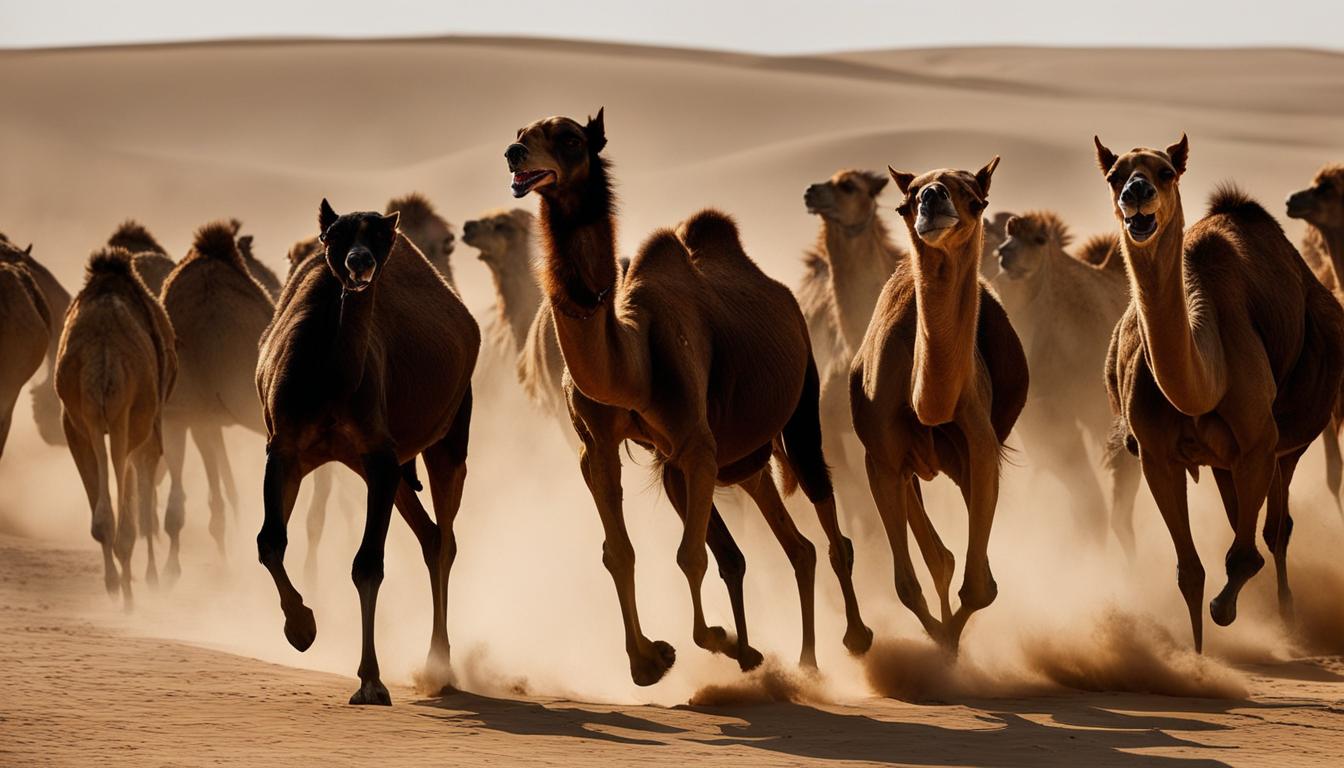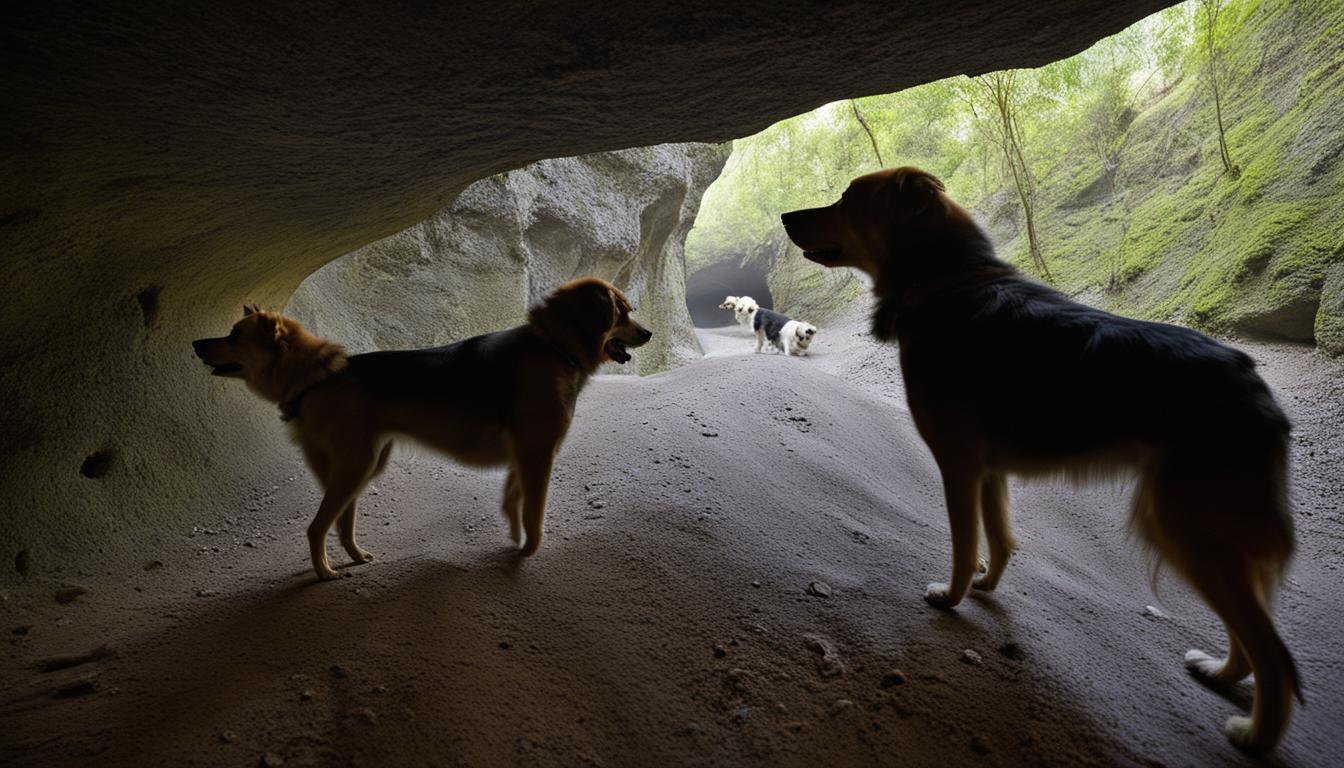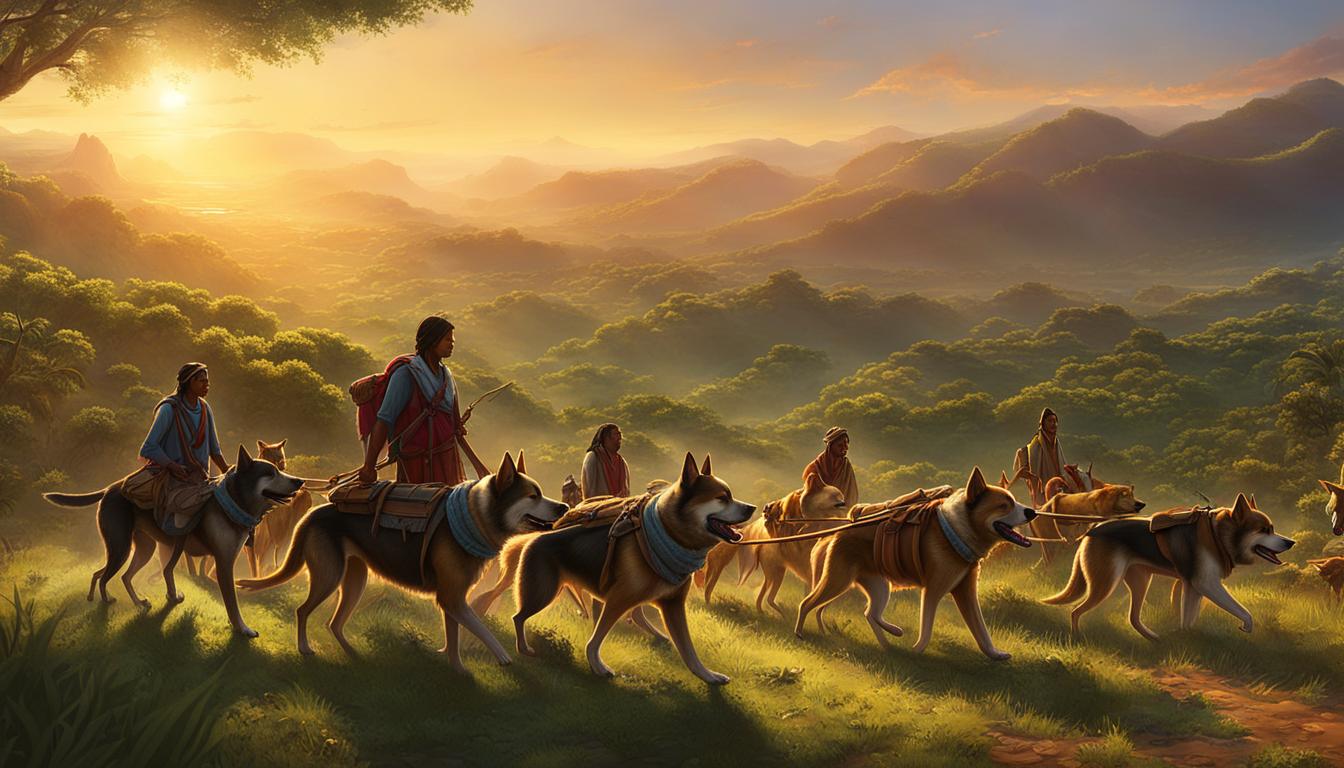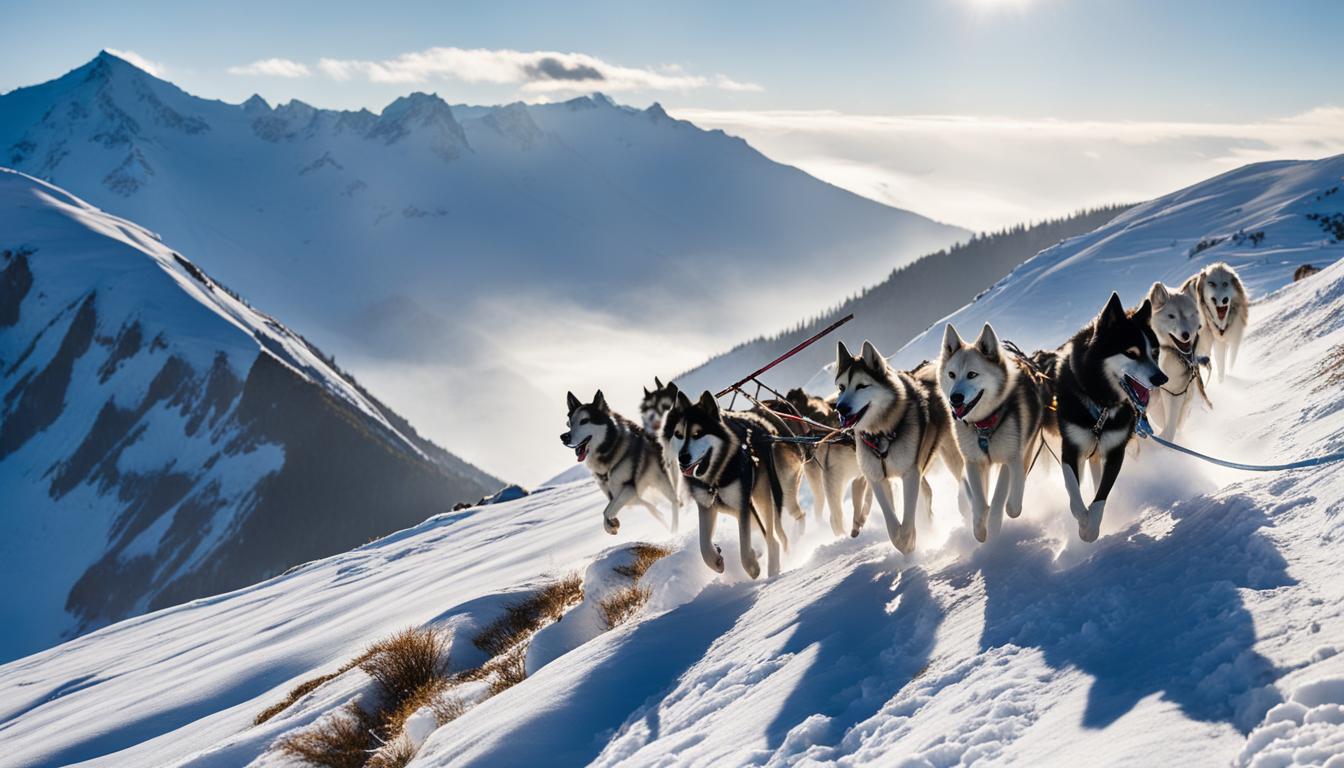When you think of the ancient trade routes that crisscrossed the vast Sahara desert, camels probably come to mind. But did you know that dogs also played a crucial role in these epic journeys? That’s right, our furry canine friends were more than just companions in North African camel caravans. They were also the protectors of desert trade routes, ensuring the safety and success of these historic Saharan expeditions.
Imagine the harsh desert landscapes, stretching as far as the eye can see. The scorching sun beating down mercilessly, and the constant threat of thirst lurking in every step. In these challenging conditions, dogs provided essential companionship and guidance to the traders. They were the trusty guides, leading the way and alerting their human counterparts to potential dangers.
Key Takeaways:
- Dogs played a crucial role in North African camel caravans
- They protected the desert trade routes
- Dogs accompanied the caravans on historic Saharan journeys
- They guided traders through the harsh desert landscapes
- Their companionship and guidance were essential for the success of the expeditions
The Role of Dogs in Desert Trade
Dogs have played a crucial role in North African trade history, serving as trusted companions and guides in desert caravan travels. These loyal canines were an integral part of the North African camel caravans, guiding and protecting traders as they ventured through the harsh desert landscapes.
Throughout history, dogs have proven to be invaluable assets to North African traders. Their keen sense of smell and ability to navigate the intricate desert terrain made them indispensable, ensuring the success of these arduous journeys. Whether it was leading the way through treacherous sand dunes or warning of potential dangers, these canine companions were crucial for the safe transport of goods and the survival of the traders themselves.
“The dogs were our guiding stars in the vast desert,” remembers Ahmed, a seasoned merchant who frequently traversed the Sahara. “Their intuition and unwavering loyalty made them more than just animals to us. They were our protectors, our friends, and our confidants.”
The North African trade routes were challenging and unpredictable, but with the guidance of their four-legged companions, traders were able to navigate these treacherous paths with confidence. The dogs’ ability to find water sources, their superior night vision, and their alertness to potential threats allowed traders to overcome the perils of the desert and successfully reach their destinations.
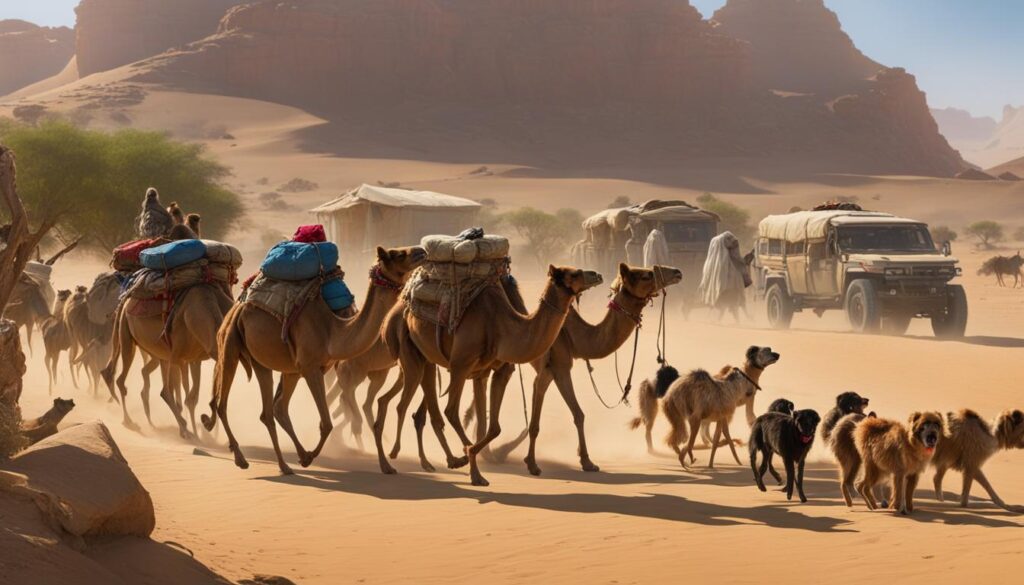
Dogs Guiding North African Traders
Traders heavily relied on their dogs to guide them through the vast expanse of the Sahara. These intelligent animals would lead caravans from one oasis to another, using their instinct and knowledge of the region to determine the safest and most efficient routes. Their presence brought a sense of security and reassurance to the traders, enabling them to focus on their trade and commerce amidst the harsh desert environment.
In addition to their navigation skills, dogs also served as companions and morale boosters for the traders. The camaraderie shared between human and canine created a bond that transcended the challenges of the desert. The dogs provided a source of comfort and companionship during long and arduous journeys, easing the solitude and hardships faced by the traders.
Challenges Faced by Caravan Travelers
Caravan travelers encountered various obstacles during their journeys through the desert. One of the most significant challenges was the scarcity of water, which posed a constant danger in the arid Sahara. The vast expanse of the desert offered limited opportunities for finding clean water sources, making it crucial for travelers to plan their routes meticulously and carry enough water supplies to sustain them.
Thirst became a dire threat in the Sahara, with dehydration leading to exhaustion, disorientation, and even death. It was essential for caravan travelers to remain vigilant and conserve water consumption to ensure their survival. The reliance on dogs in these expeditions was not only for guidance and protection but also for their remarkable ability to detect water sources in the unforgiving desert landscape.
In addition to water scarcity, Saharan crossings presented other formidable obstacles. The desert terrain was treacherous, characterized by shifting sands, intense heat, and vast stretches of barren land. The absence of landmarks made navigation challenging, and travelers had to rely on their knowledge of the stars, sun, and natural formations to stay on course. Sandstorms, extreme temperatures, and the threat of dangerous wildlife added to the perils faced by caravan travelers.
| Challenges Faced by Caravan Travelers | |
|---|---|
| 1. | Scarcity of water |
| 2. | Dangers of thirst in the Sahara |
| 3. | Obstacles in Saharan crossings |
Navigating the desert required skill, experience, and a deep understanding of the environment. It demanded constant vigilance and adaptability to overcome the challenges posed by water scarcity, thirst, and the harsh conditions of the Sahara. Caravan travelers had to demonstrate resilience and resourcefulness to successfully surmount these obstacles in their pursuit of trade and commerce.
Organizing Caravan Expeditions
When it comes to organizing caravan expeditions, meticulous planning and preparation are key. From buying camels for desert travel to ensuring all necessary supplies are in order, every detail must be carefully considered. Here’s a closer look at the logistics involved in preparing for a successful caravan journey.
Buying Camels
One of the first tasks in organizing a caravan expedition is acquiring the camels that will be used for desert travel. Camels are well-suited for traversing the harsh desert terrain, with their ability to withstand long periods without water and their endurance for long journeys. Merchants carefully select camels based on their health, strength, and suitability for the journey ahead.
Preparations for the Journey
Once the camels are secured, preparations for the journey begin. This includes allowing the camels to fatten up before setting off, ensuring they have enough energy to endure the long stretches between oases. Merchants also gather and organize their merchandise, saddlery, and supplies, checking that everything is in order before departure.
In addition to the physical preparations, it is essential to consider safety measures and contingencies. Caravan leaders may appoint guards or hire additional guides to ensure the safety of the expedition. They also assess potential risks and plan alternative routes in case of unforeseen circumstances such as a sandstorm or a blocked passage.
Logistics of Desert Trade
The logistics of desert trade are complex, involving the coordination of a variety of elements. Caravans need to plan their itinerary, taking into account the distance between oases and the availability of resources along the route. They must also consider the timing of the journey, as the scorching desert heat can make travel treacherous during certain months.
Furthermore, caravan leaders must negotiate with local tribes for safe passage through their territories and arrange for rest stops and resupply points along the way. These logistical challenges require careful coordination and communication between the caravan leaders, traders, and the communities they encounter.

Table: The Logistics of Desert Trade
| Aspect | Considerations |
|---|---|
| Camel Acquisition | Selection of healthy, strong camels for the journey |
| Preparations | Fattening camels and organizing supplies |
| Safety Measures | Appointing guards, hiring additional guides, planning alternative routes |
| Itinerary Planning | Mapping out the distance between oases and resource availability |
| Timing | Avoiding extreme desert heat during certain months |
| Negotiations | Arranging safe passage through local tribal territories |
| Rest Stops and Resupply | Coordinating rest points and resupply locations |
Navigating the Desert Terrain
When it comes to traversing the vast expanse of the Sahara desert, the challenges of navigation are daunting. The sheer size and harsh conditions of the desert can make it difficult to find your way. This is where local knowledge becomes essential. Relying on the expertise of tribes like the Masufa, who have intimate familiarity with the terrain, is crucial for successfully navigating the desert.
The Masufa people, who have inhabited the Sahara for centuries, possess a deep understanding of the desert’s intricacies. They can identify the safest routes, avoid treacherous areas, and locate water sources hidden beneath the surface. Their wisdom and guidance have proven invaluable to caravan travelers seeking to navigate this challenging landscape.
Through years of experience, the Masufa have honed their skills in desert navigation. They can read the subtle signs of the desert, such as wind patterns, sand dunes, and the positioning of the stars. This knowledge allows them to guide caravans along the most efficient and secure paths, minimizing the risks associated with desert travel.
The Significance of Local Knowledge
Local knowledge not only helps in avoiding danger but also contributes to the preservation of historical trade routes. The Masufa have passed down their expertise from generation to generation, ensuring the continuity of these vital paths that have shaped the history of North African trade. Without their guidance and the reliance on their insights, many trade routes may have been lost to the shifting sands of the Sahara.
In summary, navigating the Sahara is no easy feat. It requires a deep understanding of the terrain and the ability to interpret its subtle signs. Caravan travelers rely on the knowledge and expertise of local tribes, such as the Masufa, who possess the wisdom and skills necessary to guide them through this challenging landscape. By embracing their expertise, caravan expeditions are able to successfully navigate the desert and keep the flame of North African trade alive.
| Challenges of Desert Navigation | Benefit of Local Knowledge |
|---|---|
| Unpredictable sandstorms | Ability to predict and navigate away from dangerous areas affected by sandstorms |
| Lack of visible landmarks | Capability to identify subtle signs in the desert to determine direction |
| Scarcity of water sources | Knowledge of hidden water sources and how to access them |
| Treacherous terrain | Understanding of the safest routes to minimize risks during the journey |
Caravan Life and Daily Struggles
Caravan life in the desert was a constant battle against the elements, with various daily struggles that tested the resilience and resourcefulness of the travelers. One of the challenges faced by the caravan members was the persistent presence of fleas and flies. These annoying pests would swarm around the caravans, pestering both humans and animals alike. The only respite from their relentless presence was to constantly swat them away while enduring the occasional sting.
Another hazard that posed a threat to the caravan travelers were encounters with snakes. The Sahara was home to various snake species, some of which were venomous. The presence of snakes added an element of danger to an already perilous journey. Travelers had to remain vigilant and be prepared to handle any encounters with these slithering reptiles, knowing that a single bite could have dire consequences.
“In the vast expanse of the Sahara, one can’t help but feel a sense of awe and wonder. The desert is both beautiful and unforgiving, a place where the line between life and death is often razor-thin.” – Saharan traveler
Aside from the physical challenges, there were also stories of mischievous desert demons that would play tricks on unsuspecting travelers. These supernatural beings were said to whisper misleading directions, leading the caravan astray and causing delays. While some dismissed these tales as mere superstition, others believed in their existence, taking extra precautions to ward off any potential encounters with these mischievous creatures.

| Challenge | Solution |
|---|---|
| Fleas and Flies | Constant swatting and enduring the occasional sting |
| Encounters with Snakes | Vigilance and preparedness to handle snake encounters |
| Dealing with Desert Demons | Guarding against potential encounters with supernatural beings |
Oasis Towns: Key Hubs in Sahara Trade
Oasis towns played a pivotal role in the flourishing trade networks that crisscrossed the Sahara desert. These towns served as vital hubs along the trade routes in North Africa, facilitating the exchange of goods and fostering economic growth in the region. The significance of desert commerce cannot be overstated, as it not only stimulated economic activity but also shaped the cultural landscape of the Sahara.
Trade routes in North Africa connected these oasis towns, enabling the flow of valuable commodities such as gold, salt, ivory, and spices. These routes were crucial for sustaining long-distance trade, and the oasis towns served as resting points and marketplaces for caravan travelers. Merchants from various regions would converge in these towns, creating vibrant marketplaces where goods and ideas were exchanged.
The Role of Oasis Towns
Oasis towns offered a respite from the harsh desert environment, providing essential resources such as water, food, and shelter to weary travelers. They were strategically located near natural springs and wells, ensuring a reliable water supply for both people and animals. These settlements also boasted bustling markets, where caravans unloaded their goods and conducted trade with local merchants.
The trade conducted in these oasis towns had a profound impact on the local communities. It brought wealth and prosperity, leading to the development of sophisticated urban centers with architectural marvels such as grand mosques, palaces, and fortified walls. The cultural exchange that took place in these towns enriched the fabric of the Sahara, as merchants, scholars, and travelers from different regions came together, fostering collaboration and the spread of ideas.
The enduring legacy of oasis towns in Sahara trade is a testament to the resilience and ingenuity of the people who navigated the challenging desert terrain. These vibrant centers of commerce not only fueled economic growth but also played a crucial role in connecting communities and fostering cultural exchange across the vast expanse of the Sahara.
| Oasis Towns in Sahara Trade | Trade Routes | Significance of Desert Commerce |
|---|---|---|
| Timbuktu | Trans-Saharan Trade Route | Facilitated the exchange of salt, gold, and other goods |
| Ghadamès | Fezzan Trade Route | Connected North Africa with sub-Saharan Africa |
| Ghat | Ghat Trade Route | Key center for trade between North Africa and the Sahel region |
| Tafilalt | Tafilalt Trade Route | Renowned for trade in dates and other agricultural products |
Conclusion
The history of North African camel caravans is intertwined with the remarkable role played by dogs. These loyal companions served as both guides and protectors, ensuring the success of desert trade routes. Their presence in these historic Saharan journeys cannot be understated, as they navigated the treacherous terrain, safeguarding the traders every step of the way.
The historical significance of desert trade cannot be overlooked. It shaped the cultural and economic landscape of North Africa, fostering connections between distant communities and facilitating the exchange of goods. The thriving commerce in oasis towns along the trade routes was made possible by the resilience and determination of these caravan travelers.
But it is the dogs that truly stand out in this tale. Their unwavering loyalty, intelligence, and bravery made them indispensable companions. Whether guiding the caravans through the vast expanse of the Sahara or protecting them from potential dangers, these dogs played a vital role in the success of North African camel caravans – a testament to the unique bond between humans and animals.
As we look back on the legacy of desert trade, let us not forget the impact of these remarkable animals. They left an indelible mark on the history of North Africa, reminding us of the ingenuity and resourcefulness of those who traversed the desert in pursuit of trade and prosperity.
FAQ
Did dogs really play a crucial role in North African camel caravans?
Yes, dogs were essential companions and guides for the caravan travelers, ensuring their safety and success in the desert.
What challenges did caravan travelers face in the desert?
Caravan travelers faced challenges such as water scarcity, dangers of thirst, and the harsh desert landscapes.
How did caravan expeditions prepare for their journeys?
Caravan expeditions involved careful organization and preparation, including buying camels, fattening them up, and ensuring all supplies were in order.
How did travelers navigate through the Sahara desert?
Travelers relied on the expertise and knowledge of local tribes who were familiar with the terrain and the safest routes.
What were some of the daily struggles faced by caravan travelers?
Caravan travelers had to deal with fleas, flies, encounters with snakes, and even stories of mischievous desert demons.
What was the role of oasis towns in desert trade?
Oasis towns served as hubs along the trade routes, facilitating commerce and the exchange of goods.

